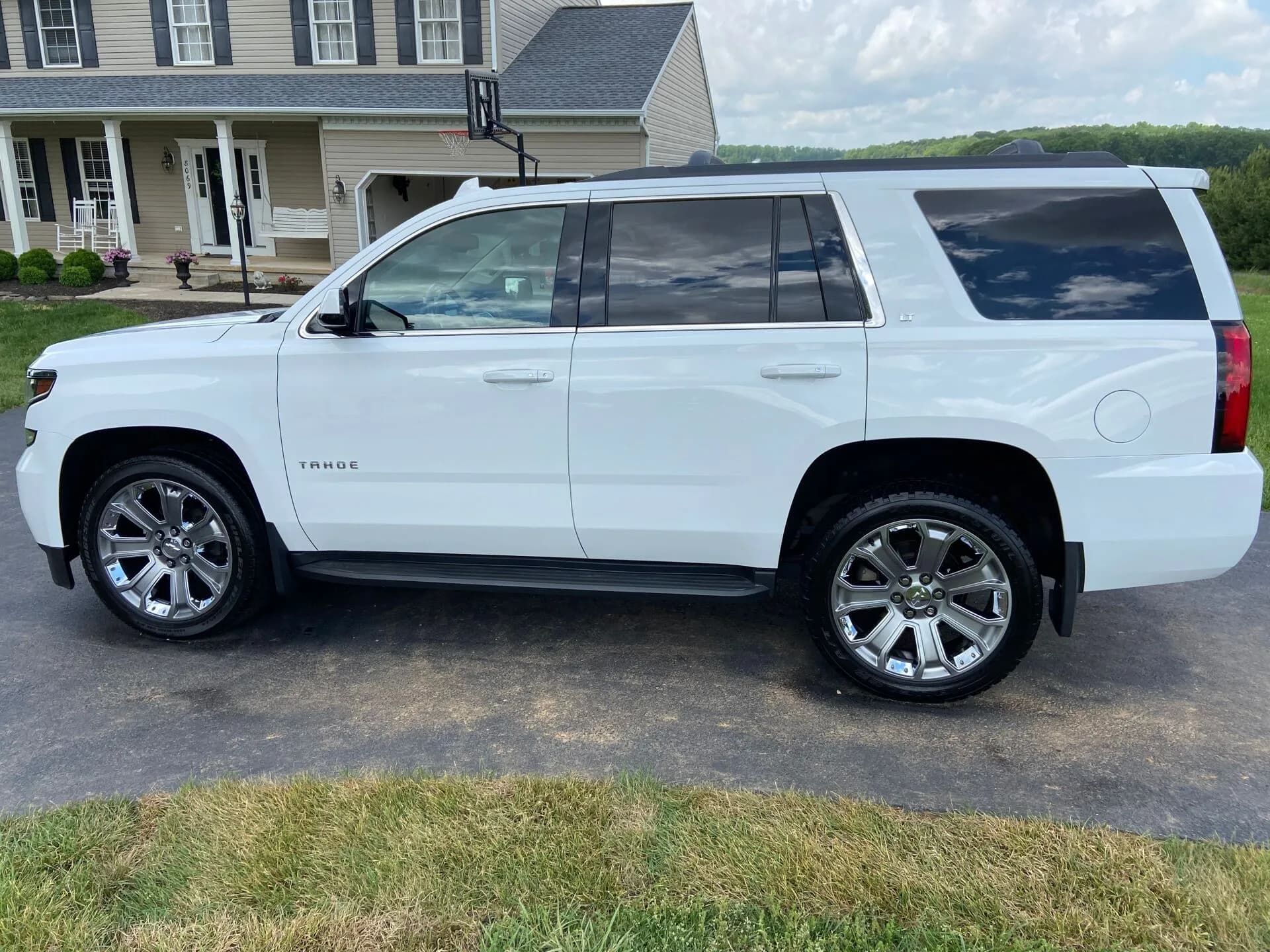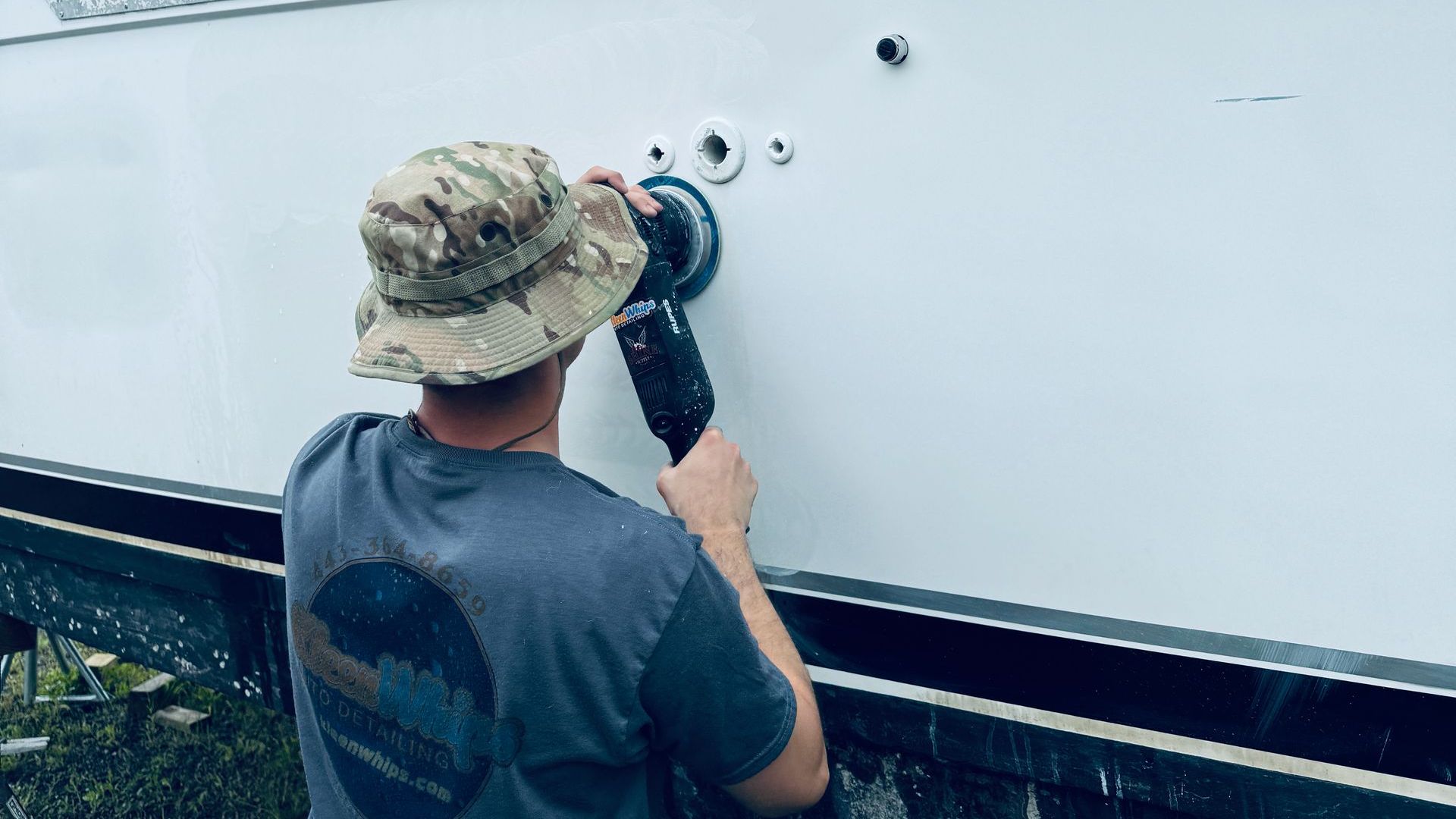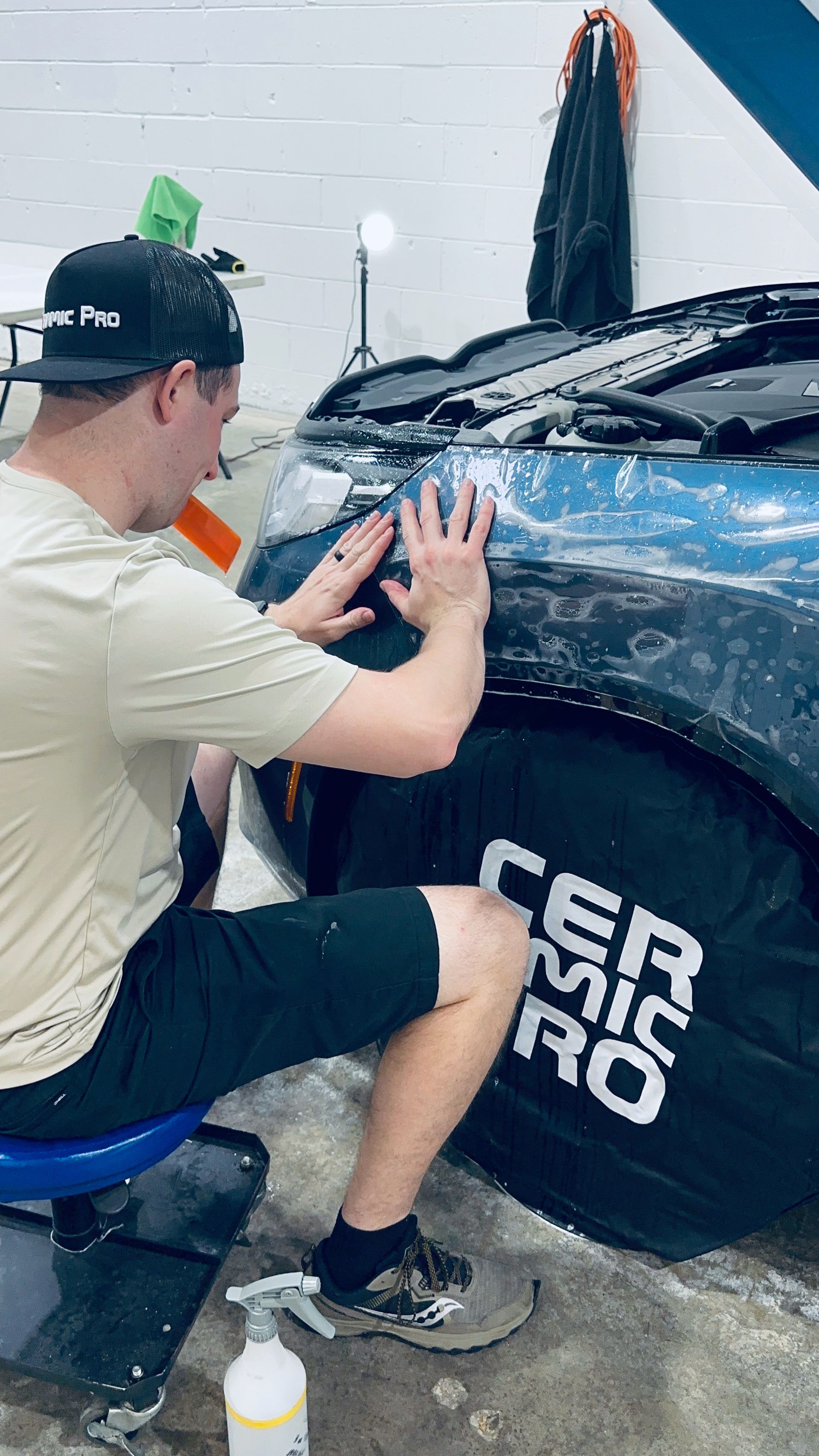Enhancing Vehicle’s Aesthetic: How Ceramic Coating Revives a Car's Paint & Shine
CALL (443) 364-8659
Deep in the heart of every car enthusiast, there's an unquenchable thirst for shine, gloss, and longevity, which is often met with regular wax jobs.
But what if we told you there was an even better solution? A method so effective that it could keep your vehicle looking showroom-fresh for years to come!
Unveiling the magic of ceramic coating—a game-changing innovation that will give your car a long-lasting, luscious radiance similar to the fresh gloss of tree sap while reducing maintenance time.
In this ultimate guide, we will pull back the curtains on how it revitalizes your car's paint and shine. Prepare to unlock a world where glossy finishes thrive and dullness fades into oblivion.
Let’s dive in!
Ceramic coatings create a durable, hydrophobic barrier that repels water, grime, and impurities. This protective layer not only helps keep the car clean but also enhances its natural color and luster, making the paint appear brighter and shinier, reminiscent of the translucent shimmer of tree sap.
Additionally, the coating provides an extra layer of protection against UV radiation, acidic precipitation, bird waste, and chemical substances that can dull or damage the paint over time.
By resisting minor abrasions and swirl marks as well, it keeps the paint in excellent condition.
Overall, using a high-quality
ceramic coating can help revive a car's paint and shine, giving it a like-new finish that lasts for several years.
What Is a Ceramic Coating?
Ceramic coating is a popular protective layer that is applied to a car's paintwork to enhance its appearance and provide long-lasting protection. Unlike traditional wax or sealant, ceramic coatings create a durable, water-repellent barrier on the surface of the car's paint, protecting it from environmental harm.
This hydrophobic nature allows water, grime, and impurities to bead up and easily slide off, making regular washing and maintenance much easier, whether you're dealing with summer dust or stubborn tree sap.
But what exactly is a ceramic coating made of?
Well, it typically consists of nanoparticles of liquid polymers that bond with the car's paint molecularly. When properly applied, these coatings form a thin yet strong layer that can resist UV radiation, acidic precipitation, bird waste, and chemical substances.
They also offer resistance to minor abrasions and swirl marks, keeping the paint in excellent condition. It is important to note that there are various types of ceramic coatings on the market.
Consumer-grade ceramic coatings are readily accessible but may not provide the same level of longevity and durability as prosumer-grade or professional-grade options.
It is recommended to choose an installer that uses a professional-grade ceramic coating for long-lasting protection against elements ranging from harsh weather conditions to tree sap.
- According to a study by the Polymer Material Science Engineering team, ceramic coatings can raise the gloss value of a car surface by up to 10%.
- Research conducted in 2020 indicated that properly applied ceramic coatings can last three times longer than traditional wax or sealants, significantly extending the longevity and shine of a car's paint job.
- According to the International Journal of Engineering & Technology, high-end professional-grade nano-ceramic coatings provide more than 90% resistance to chemicals and UV rays that dull car paints.
Restoring Car's Paint & Shine with Ceramic Coating
Now that we understand what ceramic coating is, let's explore how it can revive a car's paint and shine, giving it the irresistible allure of a brand-new vehicle fresh off a showroom floor in Bel Air, Maryland.
When a ceramic coating is professionally applied to a vehicle, it can significantly enhance the gloss and shine of the car's natural color.
The reflective properties of the coating create an amplified depth and clarity in the paintwork, giving it a stunning showroom-like finish.
This rejuvenation can make older cars look more vibrant, shining brighter than the tree sap that coats forest paths, while maximizing the beauty of newer vehicles.
Furthermore, ceramic coatings act as a shield against various environmental elements that can damage the car's paint over time, such as relentless sunbeams and sticky tree sap.
The high UV resistance prevents fading and oxidation from prolonged sun exposure. Acidic precipitation, such as rain or bird droppings, has a harder time penetrating the coating, reducing the risk of etching and staining the paint surface.
Additionally, ceramic coatings help reduce the appearance of swirl marks and even instances of paint damage.
While they don't eliminate the possibility of these imperfections altogether, their high levels of hardness act as a sacrificial layer, absorbing light abrasions and minimizing their visibility.
This protective layer is much like a paint coating, offering a smoothing and polishing effect that helps maintain a smoother and more uniform appearance of the car's paint, enhancing its overall shine.
Because of their hydrophobic properties, cars with ceramic coatings require less frequent washing and detailing. This polished paint coating allows water and dirt to easily slide off the surface, reducing the accumulation of grime.
The result is less paint damage over time. This not only saves time but also reduces the chances of introducing swirl marks during the cleaning process.
Now that we understand how
ceramic coating can restore and protect a car's paint and shine, let's dive deeper into the other benefits it offers and some considerations to keep in mind.
The Role of Chip-Resistance in Enhancing Shine
When it comes to a car's appearance, one of the key factors that can greatly impact its overall shine is chip resistance.
A vehicle's paint can be subjected to a variety of hazards, such as gravel, stones, and road debris, that can cause chipping and dullness over time.
However, with the application of a ceramic coating, the car's paint receives an additional protective layer. This coating acts as a smooth, polished layer, minimizing paint damage and preserving the shine.
Ceramic coatings create a durable, water-repellent barrier on a car's paint, helping to reduce paint damage. This includes the potential harm that small chips and dings, which are frequent on the road, may cause.
The strong bond formed by the ceramic coating acts as a shield against superficial impacts that would otherwise mar the surface. As a result, the coating helps to maintain the integrity of the paintwork, preventing any loss of gloss or shine that could occur due to these flaws.
Additionally, chip resistance plays an essential role in preserving the aesthetic appeal of a car. When chips and scratches start appearing on a vehicle's exterior, they can disrupt the even reflection of light off its surface, leading to a diminished shine.
But, with continuous polishing and a ceramic coating that offers increased resistance against chips and abrasions, the natural color and luster of the paint stand out vibrantly.
Sealant's Role in Warding Off Rust
Sealants are designed to provide an additional layer of protection on top of the ceramic coating. They act as a sacrificial barrier that absorbs any potential impacts or scratches to prevent them from reaching the underlying paint, much like a protective paint coating.
This sacrificial layer absorbs the brunt of any minor abrasion details that are frequently overlooked, leaving the actual paintwork undamaged and free of water spots. It is similar to how professional detailers would meticulously wipe down a car after washing it with a microfiber towel to prevent water spots.
Moreover, sealants create a hydrophobic surface that repels water and moisture, akin to the way a microfiber towel works, making it more difficult for rust to develop.
Imagine accidentally brushing against a rough surface while opening your car door. Without a protective sealant layer, this contact could potentially leave behind visible scratches or stubborn water spots on your vehicle's exterior.
However, if you have used a high-quality sealant that is based on detailers' best practices, it will absorb the frictional force and lessen any obvious damage to the paintwork.
In addition, if there are any small scratches that do occur, the hydrophobic properties of the sealant would deter moisture accumulation and reduce the risk of rust formation in those areas.
The Lifespan and Categories of Ceramic Coating
As an automotive enthusiast or someone looking to protect their vehicle's paint and enhance its shine, longevity plays a significant role.
It can last up to two to three years, depending on the car owner's care. However, it's important to note that this lifespan can vary based on factors such as coat quality, vehicle usage, road conditions, weather, cleaning products used, and parking conditions.
Interestingly, the use of a microfiber towel and attentive care of water spots can also affect the duration of your coating's lifespan.
Now let's explore the various categories of
ceramic coating available on the market:
Consumer-Grade Ceramic Coating
Consumer-grade ceramic coatings are typically designed for people who want to apply the coating themselves.
These coatings are useful tools that detailers use in a manner similar to microfiber towels. These coatings are generally more user-friendly and come in kits that include all the necessary materials and instructions for application, barring pesky water spots on surfaces.
While they may not offer the same level of durability and longevity as professional-grade coatings, consumer-grade options still provide significant benefits.
For car owners who are willing to put in the time and effort to properly prepare their vehicle's surface and follow instructions meticulously during the application process, consumer-grade ceramic coatings can provide excellent protection against corrosion, oxidation, and erosion.
They also contribute to reducing paint correction costs by minimizing damage from harmful environmental elements.
Prosumer-Grade Ceramic Coating
Prosumer-grade ceramic coatings bridge the gap between consumer-grade and professional-grade options.
These coatings are typically aimed at car enthusiasts who seek higher performance than what consumer-grade products offer but may not require or have access to professional application techniques.
This coating often provides improved durability and longevity compared to consumer-grade options.
Professional-Grade Ceramic Coating
While consumer-grade coatings can deliver satisfactory results when applied with attention to detail, which includes avoiding water spots and using a microfiber towel for the final wipe-down, they still don't match the level of protection and longevity of professional-grade coatings.
These coatings, when applied by experienced detailers with extensive knowledge, provide exceptional protection and a showroom-like finish free of water spots that can last for several years.
Professional-grade ceramic coatings represent the pinnacle of durability and performance in the world of ceramic coatings. These coatings often come with warranty options, offering different levels of protection and durability.
Brands such as Opti-Coat PRO, Modesta Glass Coating, and Ceramic Pro are renowned for their professional-grade ceramic coating products.
For example, Opti-Coat PRO is a clear ceramic polymer coating that chemically bonds to the factory clear coat, providing long-lasting protection.
It's essential to note that the application of professional-grade ceramic coatings goes beyond a simple DIY process.
Thorough preparation and correction, which include detailed washing, clay bar treatment, and paint correction, are necessary before applying the coating.
The vehicle is typically moved to a sealed installation booth, where the body is meticulously wiped down with alcohol and water before the coating is applied in sections and heat baked for optimal results.
Now that we understand the different categories of ceramic coating available, let's traverse further into exploring how they compare in terms of performance and application techniques.
Consumer-Grade vs Prosumer-Grade vs Professional-Grade
When choosing between consumer-grade, prosumer-grade, or professional-grade ceramic coatings, several factors need to be considered.
The decision effectively pinpoints your specific needs, budget, desired level of protection, and longevity, as well as your ability or willingness to invest time into the application process.
Consumer-grade ceramic coatings offer a more affordable option for those who want to protect their vehicle but may not have the budget for professional-grade products or are leaning towards a DIY approach.
Despite their low cost, these coatings can provide adequate protection when properly applied.
They are appropriate for people who are willing to invest time learning about proper surface preparation and diligently following instructions during application.
Prosumer-grade ceramic coatings appeal to car enthusiasts looking for improved performance and longevity over consumer-grade options without venturing into professional-grade territory.
Although these coatings may require a slightly higher investment, when applied according to the instructions, they can provide superior protection and shine.
Professional-grade ceramic coatings are the most durable, long-lasting, and visually appealing. They are ideal for car owners who value long-term protection and showroom-like finishes and are willing to enlist professional application assistance.
However, because of the skill, experience, and specialized equipment required for application, professional-grade coatings are often more expensive.
There is a discourse where some argue that consumer-grade or prosumer-grade options can offer satisfactory results if applied properly and maintained regularly.
In contrast, others believe that professional-grade coatings provide unparalleled protection and longevity, thereby making them worth the investment.
Choosing between different grades of ceramic coating is similar to deciding between a DIY home improvement project versus hiring professional contractors.
While DIY projects can save money and be completed successfully with proper research and effort, professional experience often guarantees superior results and saves time.
In the end, the decision should be based on your individual requirements and resources. Whether you choose
consumer-grade,
prosumer-grade, or
professional-grade ceramic coating, incorporating this protective layer on your vehicle's paintwork can revive its appearance, enhance its shine, and safeguard it against environmental elements.
The Art of Applying Ceramic Coating for Optimal Results
Applying ceramic coating to your car's paint requires precision, patience, and attention to detail. To achieve optimum results, it is essential to follow a systematic approach that ensures the coating adheres properly and provides maximum protection.
Here are some key steps and techniques to consider when applying ceramic coating:
1. Thoroughly Clean and Prep the Surface: Before applying the ceramic coating, ensure that your car's paint is thoroughly washed and free from any dirt, debris, or contaminants.
Use high-quality automotive shampoo and a microfiber wash mitt to gently clean the surface. Follow up with a clay bar treatment to remove any embedded impurities or stubborn residues.
2. Correct Any Paint Imperfections: It's important to address any paint imperfections such as swirl marks, scratches, or oxidation before applying the ceramic coating.
Perform a thorough paint correction process using abrasive compounds or polishers to restore the smoothness and shine of the paint surface.
3. Ensure Proper Application Conditions: Ceramic coatings are sensitive to temperature and humidity, so it's crucial to choose an appropriate environment for application.
Ideally, work in a well-ventilated area away from direct sunlight or extreme heat. For ideal curing, the temperature should fall within the range that the manufacturer has specified.
4. Work in Small Sections: When applying the ceramic coating to your car, divide it into manageable sections (e.g., hood, roof, doors) to ensure thorough coverage and to keep the product from drying too quickly.
Start by applying a few drops of the coating to an applicator pad or microfiber cloth.
5. Use the Correct Technique: Apply the ceramic coating in a crosshatch pattern or in straight lines using light pressure. Avoid excessive rubbing or buffing, as this can cause streaks or uneven coverage.
Be mindful of using a sufficient amount of coating to ensure even distribution without wasting excess product.
6. Allow Proper Curing Time: After applying the ceramic coating, allow it to cure for the amount of time the manufacturer recommends.
This typically ranges from a few minutes to several hours, depending on the specific product. Avoid exposing the coated surface to water or other contaminants during this curing period.
7. Regular Maintenance and Protection: Once the ceramic coating has fully cured, it's crucial to maintain your car's appearance by adopting proper washing techniques and routine maintenance.
Use pH-neutral car wash soap, a soft wash mitt, and microfiber towels to prevent scratches or swirl marks.
Additionally, consider using a designated ceramic coating-compatible spray sealant or booster periodically to enhance gloss and protection.
Keep in mind that, while ceramic coatings offer long-lasting protection and enhanced shine, they are not bulletproof armor for your car's paint. Regular maintenance and care are still required to preserve its appearance and longevity.
It's important to avoid harsh chemicals or abrasive cleaning methods that can compromise the coating's integrity.
Applying ceramic coating is like an artist carefully painting a masterpiece. Each stroke and technique contributes to achieving that flawless finish and optimal protection for your car's paint.
Enhance the Visual Appeal of Your Vehicle With Kleen Whips Ceramic Coatings Installation in Bel Air, Maryland
Are you looking for a way to improve the appearance of your vehicle? Then you have come to the right place!
At Kleen Whips, we specialize in ceramic coatings that will transform your vehicle into something truly remarkable. Our ceramic coatings not only enhance the appearance of your vehicle, but they also protect it from environmental contaminants such as salt, tree sap, and bird droppings.
With our ceramic coating installation services, you can trust that your car will look pristine for years to come. So if you’re looking to give your car an upgrade, look no further than Kleen Whips!
Give us a call today for more information and to get a free consultation!






